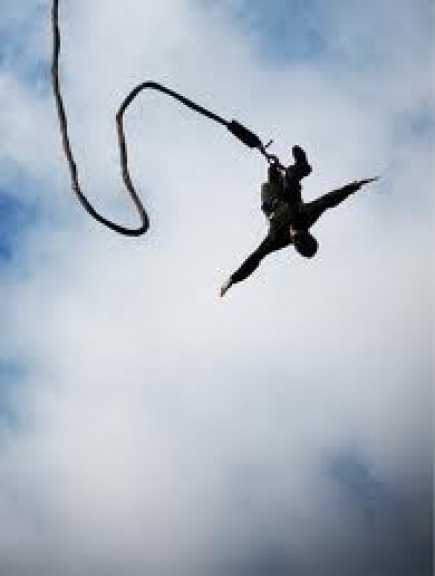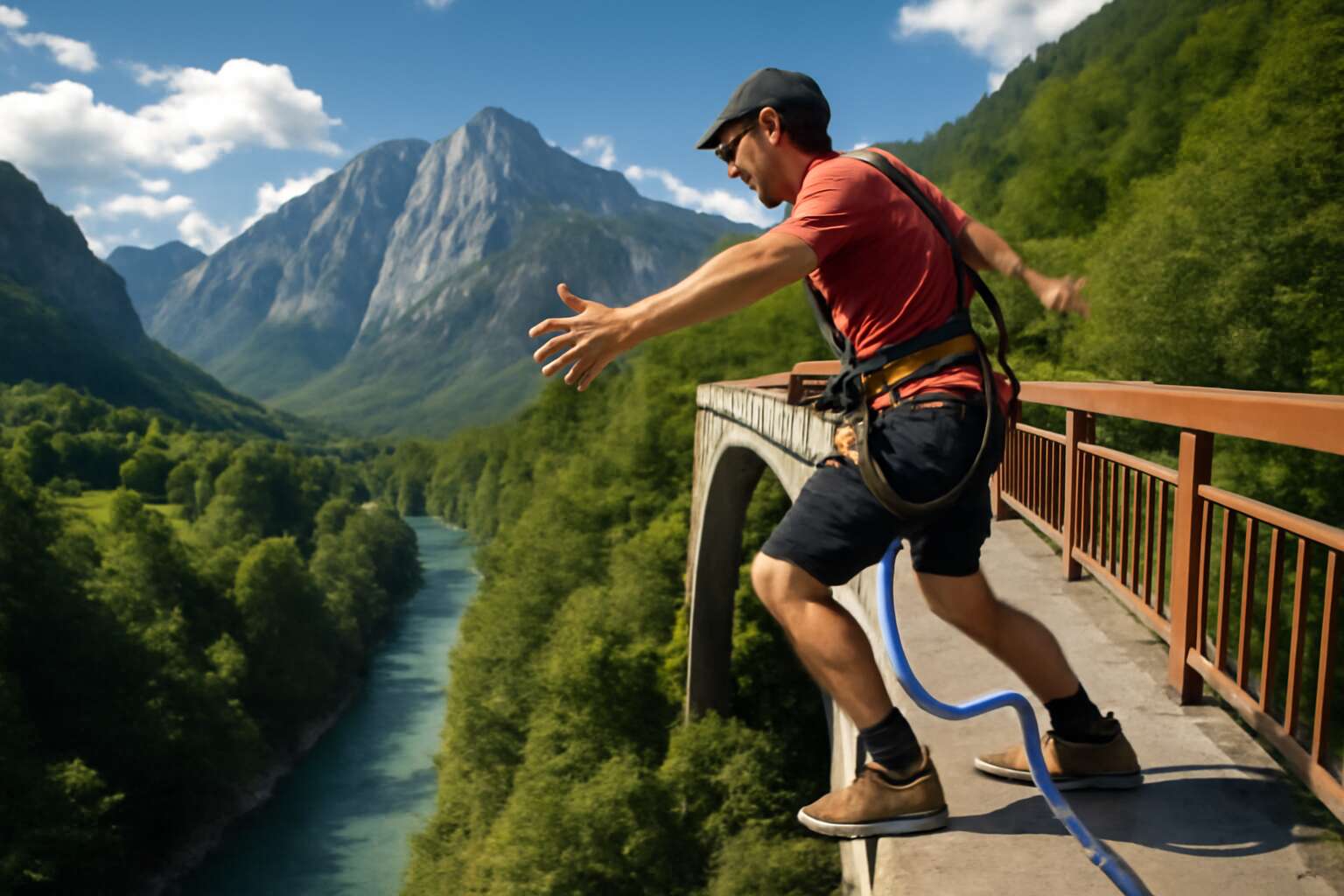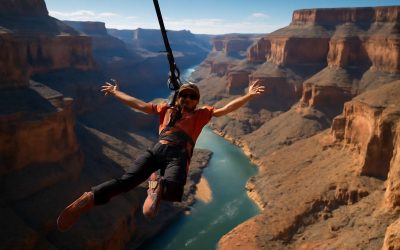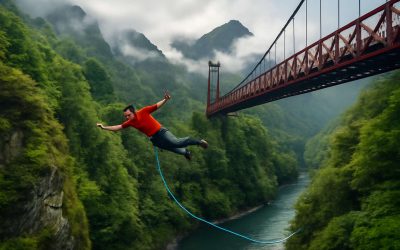Understanding Bungee Jumping
What is Bungee Jumping?
Bungee jumping is often regarded as one of the most exhilarating yet daunting adventure sports. It involves leaping from a high platform while attached to a long, elastic cord that stretches and recoils, offering a fleeting moment of weightlessness before a controlled bounce back. This sport captures the spirit of daring and freedom, but many wonder—is bungee jumping safe? Understanding the fundamentals of what bungee jumping entails can provide clarity and reassurance.
At its core, bungee jumping is a precisely engineered activity rooted in rigorous safety standards. The process begins with meticulous equipment checks—stretchable cords, harnesses, and anchors—that are tested to withstand many times the weight of the jumper. Expert operators follow strict protocols, ensuring each jump adheres to international safety guidelines. For those curious about the specifics, here are some aspects that contribute to its safety:
- Regular equipment inspections and maintenance
- Certified training for all staff
- Comprehensive safety briefings for jumpers
While the adrenaline rush is undeniable, the question remains—are the risks associated with bungee jumping manageable? The answer depends heavily on the quality of equipment, operator experience, and adherence to safety procedures. When these elements align, bungee jumping can be a thrilling yet surprisingly safe adventure. But always remember, understanding the safety measures can make all the difference in ensuring a memorable experience.
Historical Background of Bungee Jumping
Historically, bungee jumping’s roots read like a legend spun from daredevil dreams and daring folklore. Originating from the 18th-century Vanuatu tribe, who would leap from towering trees with vines tied around their ankles, it was less about safety and more about spiritual rites—think of it as ancient risk-taking with a dash of ritualistic flair. Fast forward to the 1970s, when the sport made its modern debut in New Zealand, transforming from tribal tradition into a regulated adventure sport. Since then, the evolution has been nothing short of miraculous.
Today, the question of is bungee jumping safe is answered through meticulous standards and technological innovation. The sport’s development was driven by a desire to marry adrenaline with safety, leading to the integration of sophisticated harnesses and high-tensile cords. It’s intriguing to note that the industry now operates under a framework of strict safety protocols, which include:
- Regular equipment inspections
- Certified training for operators
- Comprehensive safety briefings for jumpers
In essence, bungee jumping has come a long way from its roots as a risky ritual to a regulated adventure, where safety is woven into every leap. Still, the core question—is bungee jumping safe?—remains a nuanced one, hinging on adherence to these rigorous standards and a healthy respect for the sport’s inherent thrill. After all, nothing quite compares to the delicate dance between danger and safety that keeps this activity so irresistibly captivating.
Popular Bungee Jumping Destinations Worldwide
Across the globe, certain destinations have become renowned for their exhilarating bungee jumping experiences. From the towering Kawarau Bridge in New Zealand—considered the birthplace of modern bungee—to the stunning Bloukrans Bridge in South Africa, these sites attract thrill-seekers and sceptics alike. The appeal lies not just in the breathtaking scenery but in the assurances of safety protocols that govern each jump.
Many of these locations adhere to strict industry standards, making it easier to answer the question: is bungee jumping safe? For instance, the Bloukrans Bridge, with its 216-metre drop, operates under comprehensive safety checks, certified operators, and high-quality equipment. These destinations often feature:
- Regular equipment inspections
- Highly trained, certified staff
- Detailed safety briefings for jumpers
This rigorous approach to safety demonstrates how the most popular bungee jumping destinations prioritise risk management without sacrificing the thrill. While the activity inherently involves some risk, these sites exemplify how adherence to safety protocols makes bungee jumping a safer adventure than many imagine, provided all guidelines are followed diligently.
Safety Measures in Bungee Jumping
Standard Safety Protocols
When pondering whether is bungee jumping safe, the answer isn’t a simple yes or no. It’s a carefully orchestrated ballet of rigorous safety measures, expert oversight, and state-of-the-art equipment. While the thought of plummeting from a great height might seem like a reckless adventure, reputable operators treat safety as sacrosanct, ensuring that every leap is backed by meticulous protocols.
Standard safety protocols for bungee jumping include comprehensive equipment checks, trained staff, and strict adherence to operational guidelines. These safety measures are designed to mitigate risks and keep thrill-seekers secure. For instance, the harnesses and bungee cords must meet stringent safety standards—often tested multiple times before anyone takes the plunge.
In addition, many operators employ a detailed checklist, which might include:
- Regular inspection and certification of all gear
- Proper training for all staff members
- Weather condition assessments before each jump
- Clear communication and safety briefings for jumpers
Such robust safety measures inspire confidence—though, as with all extreme sports, a healthy dash of caution is always advisable when considering if bungee jumping is safe. After all, even the best safety protocols can’t entirely eliminate risk, but they certainly tip the scales heavily in favour of a secure experience.
Role of Certified Bungee Operators
The backbone of a safe bungee jumping experience lies in the hands of certified bungee operators. These professionals are more than just guides; they are guardians of safety, meticulously overseeing every aspect of the jump. Their expertise isn’t just a credential—it’s a vital shield that transforms what seems like a wild plunge into a calculated act of daring precision.
Certified operators adhere to rigorous safety standards, ensuring that all equipment is inspected and certified regularly. They perform comprehensive checks on harnesses, cords, and anchoring systems, leaving nothing to chance. Moreover, these experts undergo specialised training, mastering emergency protocols and rescue procedures that could make all the difference in critical moments.
To maintain optimal safety, operators follow a strict sequence of steps, including:
- Assessing weather conditions to avoid dangerous gusts or storms, which could compromise safety.
- Providing detailed safety briefings that prepare jumpers for every scenario, ensuring clear communication at all times.
- Implementing a double-verification process for all gear and safety measures before each jump.
With such stringent oversight, the question of whether is bungee jumping safe becomes less of a gamble and more a calculated leap into thrill-seeking with confidence. When you choose a reputable, certified operator, the risk is significantly mitigated, transforming a potentially supernatural experience into one of exhilarating security.
Equipment Standards and Maintenance
When it comes to the question of whether is bungee jumping safe, impeccable equipment standards and meticulous maintenance are paramount. Reputable operators invest heavily in high-quality gear that meets rigorous safety standards, ensuring every component functions flawlessly. Regular inspections and maintenance routines are not merely routine—they are sacrosanct procedures that safeguard every leap into the abyss.
To maintain optimal safety, many operators follow a strict protocol that includes:
- Frequent checks on harnesses, cords, and anchoring systems to detect wear and tear
- Replacement of ageing equipment to prevent catastrophic failure
- Calibration of safety mechanisms to ensure precise operation
This unwavering commitment to equipment excellence transforms what could be an act of reckless bravado into a calculated, controlled thrill. When combined with diligent maintenance, these measures significantly reduce the risks associated with bungee jumping, helping enthusiasts experience the adrenaline rush with peace of mind. So, while the question of is bungee jumping safe might linger in the back of your mind, know that strict adherence to equipment standards and maintenance protocols makes the leap a daring dance with safety rather than a leap of faith.
Pre-Jump Safety Checks
Before you take that heart-stopping leap, the pre-jump safety checks are where the magic (or disaster) truly begins. Despite the adrenaline-fuelled reputation of bungee jumping, the real thrill lies in knowing that every safety detail has been meticulously scrutinised. Think of it as the behind-the-scenes wizardry that transforms a potentially reckless stunt into a controlled display of daring finesse.
Reputable operators don’t leave safety to chance—they follow a rigorous pre-jump checklist that ensures each harness, cord, and anchoring system is primed for action. These checks typically include:
- Verifying the integrity of harnesses and cords for signs of wear or damage
- Ensuring all safety mechanisms are correctly calibrated and functioning
- Confirming that all equipment is correctly secured and positioned
By adhering to these detailed protocols, operators reduce the inherent risks associated with bungee jumping, making the question of is bungee jumping safe a lot less intimidating. It’s a dance of precision and vigilance—an elaborate ballet that keeps thrill-seekers safe while they experience the world from a breathtaking new perspective.
Factors Affecting Bungee Jumping Safety
Weather Conditions
Weather conditions are a pivotal factor in determining whether is bungee jumping safe on any given day. Sudden shifts in wind speed, rain, or fog can transform an exhilarating experience into a perilous one. Strong gusts can sway the jumper unpredictably, while rain can compromise the integrity of the equipment or reduce visibility, making it difficult for operators to monitor safety parameters effectively. It’s no exaggeration to say that the natural elements can turn a controlled thrill into an uncontrollable risk.
Experienced operators typically have strict protocols for assessing weather risks before each jump. They consider variables such as wind velocity, temperature, and precipitation levels, which directly influence the safety of the activity. In some locations, the following factors are scrutinised meticulously:

- Wind speed and direction
- Precipitation (rain or snow)
- Temperature and humidity
- Visibility conditions
By understanding and respecting these weather factors, operators can mitigate dangers and ensure that every jump remains a safe adventure rather than a gamble with nature’s unpredictability. This vigilance is essential in maintaining the integrity of safety standards and reassuring thrill-seekers that their leap is as safe as it is exhilarating.
Physical Fitness of Participants
Physical fitness plays a crucial role in determining whether is bungee jumping safe for an individual. A participant’s strength, agility, and overall health can significantly influence how they respond to the intense forces involved. Those who are physically unfit or have underlying health issues may face increased risks of injury or adverse reactions during the jump.
Operators often assess fitness levels before allowing participants to jump. This is not just a formality; it’s a vital safety measure. For example, individuals with heart conditions, high blood pressure, or joint problems are usually advised against attempting bungee jumping. Ensuring proper physical preparedness helps prevent accidents and guarantees a safer, more controlled experience.
- Assess medical history thoroughly
- Confirm physical readiness through a simple fitness check
- Adhere to weight and health restrictions set by the operator
By respecting these fitness standards, thrill-seekers can enjoy the adrenaline rush with peace of mind. After all, understanding the importance of physical fitness is key to answering the question, is bungee jumping safe? It’s a vital component in making sure every leap remains a safe adventure rather than a gamble with one’s health.
Quality of Equipment Used
The safety of bungee jumping hinges significantly on the quality of equipment used, which is far from a trivial matter. In fact, the longevity and integrity of harnesses, cords, and other gear determine whether an adrenaline-fuelled leap remains an exhilarating experience or turns into a perilous endeavour. It’s not just about having the latest gear, but ensuring everything adheres to rigorous safety standards.
Reputable operators invest heavily in high-grade materials, regularly inspect and maintain their equipment, and replace gear at prescribed intervals. This ongoing vigilance plays a crucial role in safeguarding participants. The elasticity of the cord, the secure fastening of harnesses, and the structural integrity of the anchoring points are all scrutinised meticulously. After all, even the slightest compromise can amplify risks, making the question of whether is bungee jumping safe largely dependent on equipment quality.
To add an extra layer of confidence, many operators follow a systematic approach:
- Conduct thorough equipment inspections before each jump.
- Utilise industry-approved safety gear with certified standards.
- Maintain detailed logs of equipment lifespan and usage history.
When these measures are consistently upheld, they transform bungee jumping from a leap into the realm of calculated adventure—where safety is woven into every fibre of the equipment. Truly, the question of whether is bungee jumping safe is inseparable from the unwavering commitment to quality and maintenance of the gear involved.
Experience of Jump Masters
The expertise and composure of jump masters are often the silent guardians in the theatre of bungee jumping, where adrenaline and caution dance in delicate balance. It is their psychological resilience and meticulous attention to detail that can transform a potentially perilous plunge into an experience of calculated thrill. When considering the question of is bungee jumping safe, the skill level and mental acuity of the operators stand as pivotal pillars of safety.
Experienced jump masters are trained to maintain unwavering focus, especially as they execute complex safety protocols under pressure. Their ability to anticipate and respond to unforeseen variables—be it equipment anomalies or environmental shifts—can mean the difference between an exhilarating adventure and a hazard. Many reputable operators embed rigorous psychological screening and continuous training into their standards, ensuring that only those with exceptional composure and precision oversee each leap.
- Meticulous adherence to safety procedures
- Deep understanding of equipment behaviour under stress
- Rapid decision-making in unpredictable conditions
Ultimately, the profound impact of a jump master’s experience and mental agility underscores a fundamental truth: the safety of bungee jumping is as much rooted in human mastery as it is in gear and environment. Their unwavering vigilance and expertise forge a vital link in the chain of safety, making the question of is bungee jumping safe intricately dependent on the professionalism and preparedness of those guiding each leap.
Risks and Common Injuries in Bungee Jumping
Potential Risks
Amid the adrenaline rush and the breathtaking vistas, a lingering question persists: is bungee jumping safe? While the thrill can seem almost otherworldly, understanding the potential risks helps paint a clearer picture. Though rare, common injuries such as sprains, strains, or minor abrasions can occur if safety protocols are compromised or equipment is misused. The exhilarating descent masks these vulnerabilities, but they remind us that even in the realm of adventure, caution remains paramount.
Potential risks for bungee jumpers are often mitigated by rigorous safety standards, yet no activity is entirely devoid of danger. Serious injuries, although infrequent, include whiplash, ligament strains, or in very rare cases, more severe trauma. These incidents highlight the importance of meticulous safety checks, proper equipment maintenance, and experienced jump masters. When these elements align, the likelihood of injury diminishes dramatically, making bungee jumping a safer pursuit than many assume.
- Equipment failure due to poor maintenance
- Improper harness fitting or securing
- Weather conditions that exceed safety thresholds
By recognising these potential pitfalls, enthusiasts can appreciate the delicate balance of risk and safety that defines the bungee jumping experience. So, is bungee jumping safe? With the right precautions and reputable operators, it often is — a dance with danger that’s beautifully controlled and undeniably exhilarating.
Most Common Injuries
While the adrenaline rush of bungee jumping is undeniably intoxicating, it’s prudent to consider the potential risks and common injuries associated with this daring activity. Despite stringent safety measures, no sport is entirely risk-free, and understanding the possible pitfalls can make the experience both exhilarating and safe. Common injuries for bungee jumpers include sprains, strains, and minor abrasions—occasions that remind us even the most meticulously planned adventure can have its moments of vulnerability.
Serious injuries are rare but not impossible. These might encompass whiplash, ligament strains, or in exceedingly rare cases, more severe trauma. Such incidents, while infrequent, serve as a sobering reminder of the importance of rigorous safety protocols. The most common injuries tend to occur when equipment is misused or safety checks are rushed, which underscores the vital role of well-maintained gear and experienced jump masters.
- Poorly fitted harnesses
- Equipment failure due to inadequate maintenance
<li Adverse weather conditions exceeding safety thresholds
Ultimately, recognising these potential hazards allows enthusiasts to appreciate the delicate dance between risk and reassurance that makes bungee jumping a uniquely controlled thrill. So, is bungee jumping safe? When conducted under reputable operators with diligent safety standards, it often is—an audacious leap into the sky, crafted with care and precision, that remains a safe pursuit for those willing to embrace its daring spirit.
Rare but Serious Accidents
While bungee jumping is generally considered a safe adventure activity, the reality is that no sport is entirely without risk. Serious accidents, though infrequent, can occur when safety protocols are not strictly followed or equipment malfunctions. Such incidents highlight the importance of rigorous safety measures and experienced operators.
Rare but severe injuries include whiplash, ligament strains, or even more grave trauma. These events are exceedingly uncommon, but they serve as a stark reminder that vigilance is essential. Equipment failure, often due to poor maintenance or improper fitting, can significantly increase these risks. That’s why adherence to strict equipment standards and thorough safety checks before each jump are non-negotiable.
In the rare event of an accident, it usually involves a combination of factors like equipment misuse or unexpected weather changes. These moments underscore the importance of qualified jump masters and well-maintained gear in ensuring that the question, “is bungee jumping safe?” remains a resounding yes for most thrill-seekers.
How Safe is Bungee Jumping Compared to Other Extreme Sports
Safety Statistics and Data
In the grand tapestry of adrenaline-fuelled pursuits, bungee jumping often sparks a debate about safety that rivals the allure of the leap itself. Statistically, bungee jumping is remarkably safer than many other extreme sports, with injury rates estimated at less than 1 in 500,000 jumps. To put that into perspective, activities like skydiving or mountain climbing carry higher risks, making bungee jumping a surprisingly secure adventure when conducted under proper protocols.
Comparing safety statistics reveals that the question of is bungee jumping safe rarely hinges on chance. Instead, it depends on meticulous adherence to safety standards and rigorous operator training. The careful maintenance of equipment and comprehensive safety checks ensure that the thrill remains within the bounds of safety, offering adventurers a leap into the extraordinary without undue peril.
Risk Comparison with Skydiving, Rock Climbing, and Paragliding
When contemplating the question, “is bungee jumping safe?”, it’s enlightening to compare its risk profile with other extreme sports like skydiving, rock climbing, and paragliding. Interestingly, the statistical safety record of bungee jumping is strikingly impressive—injury rates hover below 1 in 500,000 jumps. This figure positions bungee jumping as one of the safer adrenaline pursuits, especially considering the inherent risks associated with high-altitude or high-velocity activities.
In contrast, skydiving, often hailed as the pinnacle of free-fall thrill-seeking, presents a higher risk. According to comprehensive safety data, skydiving incidents occur at a rate of roughly 1 in 100,000 jumps. Similarly, rock climbing and paragliding, while exhilarating, carry their own dangers—particularly when safety protocols are compromised or environmental conditions are unfavourable. The key difference lies in the meticulous safety standards and operator expertise involved in bungee jumping, which significantly mitigate potential hazards.
- Proper equipment maintenance and regular safety checks
- Certified and experienced jump operators
<li- Clear weather conditions and participant fitness
When these factors align, the question of whether bungee jumping is safe becomes less about chance and more about rigorous safety culture. In essence, bungee jumping remains a remarkably controlled, secure form of adventure—offering thrill-seekers a chance to leap into the extraordinary with confidence and peace of mind.
Why Bungee Jumping Maintains High Safety Standards
When contemplating the question, “is bungee jumping safe?”, the comparison with other extreme sports reveals a compelling story of safety and risk management. Bungee jumping’s injury rate is remarkably low—less than 1 in 500,000 jumps—which positions it as one of the safest adrenaline pursuits. This statistic underscores the rigorous safety standards that underpin the sport, making it a viable option for thrill-seekers who value security.
What sets bungee jumping apart from activities like skydiving or rock climbing is the meticulous attention to safety protocols. Certified and experienced jump operators conduct comprehensive safety checks, ensuring equipment is regularly maintained and environmental conditions are suitable. This high level of professionalism and standardisation significantly reduces potential hazards, providing reassurance to those pondering whether bungee jumping is safe. Ultimately, the sport’s safety record reflects a collective commitment to excellence, making it a daring yet responsibly managed adventure.
Tips to Ensure a Safe Bungee Jumping Experience
Research and Choose Reputable Operators
In the shadowy realm of adrenaline pursuits, few experiences evoke such a visceral thrill as bungee jumping. Yet, amidst the allure of plunging into the abyss, questions echo — is bungee jumping safe? To navigate this perilous dance with gravity, it’s imperative to research and choose reputable operators.
Reputable bungee jump operators are the guardians of safety standards, meticulously adhering to rigorous protocols that transform the macabre beauty of the leap into a controlled act of daring. They employ certified personnel whose expertise is the cornerstone of a secure experience. When selecting a provider, scrutinise their safety records and equipment maintenance routines, for these are the invisible shields guarding against catastrophe.
A wise adventurer will also insist on thorough pre-jump safety checks and consider weather conditions — the fickle mistress that can turn a perfect plunge into a deadly trap. Ensuring the physical fitness of participants is another vital element, for the human body must be resilient against the unpredictable forces at play.
In this dance with danger, only the most meticulous operators, with their unwavering attention to detail and unwavering respect for safety, can tame the dark allure of the abyss.
Follow Safety Instructions Carefully
Ensuring a safe bungee jumping experience hinges on strict adherence to safety instructions. Even seasoned thrill-seekers must stay vigilant. Listening carefully to the briefing provided by jump masters can make all the difference. They will explain how to position your body, when to pull the cord, and what to expect during the bounce. Missing these crucial details can compromise safety, no matter how reputable the operator.
It’s equally vital to respect the guidelines about equipment use. Always double-check that the harness is secure and that the safety gear is in perfect condition. Many accidents occur when participants overlook small but significant instructions. Remember, your safety depends on following every step precisely, from the initial countdown to the final bounce.
For peace of mind, ask questions if anything is unclear. A responsible operator will encourage your engagement and ensure you feel confident before the leap. By taking these simple precautions, you can enjoy the thrill of bungee jumping while maintaining the highest safety standards. Ultimately, the question — is bungee jumping safe? — can be confidently answered when safety instructions are followed meticulously. Safety isn’t just a protocol; it’s a shared commitment between you and your operator.
Check Equipment and Facility Certifications
When it comes to the question—is bungee jumping safe?—the answer hinges on more than just the thrill; it’s rooted in meticulous standards and unwavering vigilance. One of the most crucial steps in ensuring safety is to check equipment and facility certifications. Reputable operators are proud to display their compliance with industry standards, often verified by recognised safety authorities. These certifications are a silent promise that every harness, cord, and safety device has undergone rigorous testing, proving their resilience against the rigours of extreme sport.
Engaging with certified facilities isn’t merely about peace of mind; it’s about trusting in a legacy of precision and accountability. Before the leap, scrutinise the documentation—look for endorsements from recognised safety bodies, and don’t hesitate to question the operator about their maintenance routines. Well-maintained equipment and certified facilities are the bedrock upon which the answer—is bungee jumping safe?—rests solidly. When safety standards are woven into every fibre of the experience, the leap becomes not only exhilarating but also remarkably secure.
Listen to Professional Guides
Listening attentively to professional guides can make all the difference when considering whether is bungee jumping safe. Experienced jump masters possess an intuitive understanding of potential hazards and are trained to handle unexpected situations with calm precision. Their guidance ensures that every participant adheres to the safety protocols, minimising risks and fostering confidence throughout the leap. Trusting their expertise often reassures even the most apprehensive thrill-seeker.
Moreover, the guidance provided goes beyond basic instructions. Guides will assess your physical readiness, explain the importance of proper body positioning, and reinforce safety measures specific to each location. This personalised approach creates a safer environment, allowing you to focus on the exhilarating experience rather than worry about the mechanics behind it. When guides emphasise safety, it underscores the real answer to— is bungee jumping safe?—which lies in the meticulous care and professionalism of those leading the adventure.
Regulatory and Certification Standards
International Safety Regulations
Regulatory and certification standards play a crucial role in ensuring that bungee jumping remains a thrilling yet safe adventure. International safety regulations set strict guidelines for operators, covering everything from equipment standards to staff training. These standards are often mandated by recognised bodies such as the British Standards Institution (BSI) or the European Norms (EN).
To maintain high safety standards, reputable bungee operators adhere to comprehensive certification protocols. Often, they undergo regular audits and inspections to verify their compliance with these regulations. Equipment used in bungee jumping must meet rigorous quality benchmarks, including durability tests and safety checks before each jump.
Choosing a certified operator is a fundamental step in answering the question, “is bungee jumping safe?” It’s important to ensure that the operator’s certifications are current, and that their safety procedures align with international standards. This thorough oversight helps minimise risks and guarantees that every jump is conducted in accordance with the highest safety protocols.
Certification of Bungee Jump Operators
When pondering the question, “is bungee jumping safe?”, it’s essential to recognise that the backbone of this adrenaline-fuelled sport lies in stringent regulatory and certification standards. Certified bungee jump operators are subject to rigorous oversight that ensures every leap is conducted within a framework designed to prioritise safety. These standards, often recognised by bodies such as the British Standards Institution (BSI) or European Norms (EN), serve as the gold standard for quality and security.
Certification of bungee jump operators involves meticulous processes, including regular audits and inspections to verify compliance with international safety protocols. Equipment used in bungee jumping must meet exacting quality benchmarks—undergoing durability tests and safety checks before each jump—to prevent unforeseen mishaps. Consequently, choosing a reputable, certified operator is one of the most crucial steps in answering the question, “is bungee jumping safe?” Ensuring their certifications are current and that their safety procedures align with global standards provides peace of mind that every leap is conducted within the safest possible parameters.
Government Oversight and Standards
Regulatory oversight plays a pivotal role in ensuring that bungee jumping remains a thrilling yet safe activity. Governments and international bodies establish strict standards to regulate the industry, making certain that safety is not compromised in pursuit of adrenaline. These standards include comprehensive guidelines for equipment quality, operational procedures, and staff training, all designed to mitigate risks.
Most reputable bungee jumping operators adhere to these rigorous standards, often obtaining certifications from recognised organisations such as the British Standards Institution (BSI) or European Norms (EN). To maintain compliance, they undergo routine audits and inspections, which serve as a safeguard against lapses in safety procedures. This regulatory framework acts as a reassuring barrier, ensuring that when you ask, “is bungee jumping safe?,” the answer is rooted in enforcement and accountability.
In addition to national oversight, international safety regulations help unify the industry’s safety protocols, offering a consistent benchmark for quality. For example, the implementation of safety management systems and adherence to global safety standards ensures that each leap is conducted within a secure framework. Ultimately, these layered standards foster an environment where the thrill of bungee jumping coexists with a profound commitment to safety, making it a sport where risk is carefully managed and minimised.




0 Comments